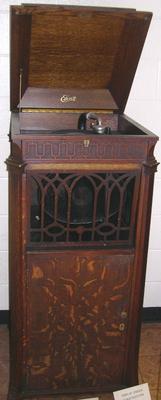Phonograph [Edison Diamond Disc]
Maker and role
Thomas A. Edison Incorporated, Manufacturer
Production date
Circa 1917
See full details
Object detail
Accession number
1982.203
Production period
Description
Edison Diamond Disc C 19 upright phonograph. The unit consists of a tall wooden cabinet. There is an opening on the front for storage of extra records. The lid on top is hinged and opens to reveal a large turntable and a gooseneck tuner arm. There is a crank handle on the right to wind up the mechanism. This phonograph plays exceptionally thick ¼" records which were recorded by the "Hill and Dale" method.
Brief History
Thomas Edison invented the cylinder phonograph in 1877 but, while it was well received, he put the development of it aside to work on developing the incandescent light bulb. Others, including Alexander Graham Bell, developed the phonograph further and eventually Edison returned to it, introducing his Improved Phonograph in 1888. Cylinder phonographs such as this peaked in popularity around 1905, after which recordings on discs and the machines that played them began to dominate the market.
The Edison Company, moving with the times, began working on developing a disc and player. The aim was to produce a superior-sounding disc that would outperform the rivals' shellac records, which were prone to wear and warping. Edison’s chief chemist, Dr Jonas Aylsworth, mixed phenol and formaldehyde with wood-flour and a solvent, which was then moulded into a heat-resistant disc which always remained flat. A phenolic resin varnish called Condensite was applied to the core, and then the disc was stamped in the record press. The finished 10" disc was heavier than most others, partially due to its 1/4" thickness. A diamond point was used for the stylus. The Disc Phonograph and the Edison Discs were designed to be an entire system, incompatible with other discs or disc players, and were first shown to the public in 1911.
By 1917, after an initial reluctance from the public, the Disc Phonograph was enjoying success in the marketplace. In the early 1920s radio began to compete with phonographs and the company needed to adapt, introducing long-playing records in 1926 and attachments that enabled other records to be played on Edison phonographs. In 1929 however the Edison disc business closed, and the company switched its focus to manufacturing radio-phonographs.
The Edison Company, moving with the times, began working on developing a disc and player. The aim was to produce a superior-sounding disc that would outperform the rivals' shellac records, which were prone to wear and warping. Edison’s chief chemist, Dr Jonas Aylsworth, mixed phenol and formaldehyde with wood-flour and a solvent, which was then moulded into a heat-resistant disc which always remained flat. A phenolic resin varnish called Condensite was applied to the core, and then the disc was stamped in the record press. The finished 10" disc was heavier than most others, partially due to its 1/4" thickness. A diamond point was used for the stylus. The Disc Phonograph and the Edison Discs were designed to be an entire system, incompatible with other discs or disc players, and were first shown to the public in 1911.
By 1917, after an initial reluctance from the public, the Disc Phonograph was enjoying success in the marketplace. In the early 1920s radio began to compete with phonographs and the company needed to adapt, introducing long-playing records in 1926 and attachments that enabled other records to be played on Edison phonographs. In 1929 however the Edison disc business closed, and the company switched its focus to manufacturing radio-phonographs.
Marks
Edison Maker's Mark
Trademark / Thomas A. Edison / Edison disc phonograph / Patent Nov, 17,1903: Jan, 30, 1906: Feb, 4, 1908: March 11, 1913: Sep, 15, 1914: May 23, 1916. / C 19 SM-111386 / Thomas A. Edison, Inc., Orange, N.J., U.S.A Maker's Plate
Trademark / Thomas A. Edison / Edison disc phonograph / Patent Nov, 17,1903: Jan, 30, 1906: Feb, 4, 1908: March 11, 1913: Sep, 15, 1914: May 23, 1916. / C 19 SM-111386 / Thomas A. Edison, Inc., Orange, N.J., U.S.A Maker's Plate
Media/Materials
Credit Line
Thomas A. Edison Incorporated. Circa 1917. Phonograph [Edison Diamond Disc], 1982.203. The Museum of Transport and Technology (MOTAT).
Related exhibitions


Public comments
Be the first to comment on this object record.